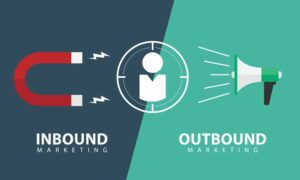What is Inbound Marketing?
Before we define what Inbound Marketing is, let’s first define what it is not. It’s not what most people think of when they think of traditional marketing or advertising. That’s traditional advertising, and it is, by nature, interruptive. You’re driving down the street looking at the trees and BAM! a billboard. You’re watching your favorite show and BAM! a commercial. You’re ducking down into the subway station and BAM! every wall, everywhere you look, is trying to sell you something.
It’s not bad necessarily, but it does reinforce that old saying about how 50% of your advertising spend is wasted (the problem, of course, that you don’t know which 50%).
The problem with outbound marketing
With traditional outbound marketing, you blast your message out to everyone as loud as you can and cross your fingers that the right people hear it and respond.
But there’s a problem with traditional outbound advertising, isn’t there? We see so much advertising all the time that we don’t really pay attention anymore, do we? At the same time, it’s becoming more affordable to advertise across new channels so the number of advertisers is increasing. So with an increase in competition and a decrease in the average bear’s attention span, we’re beginning to see that the cost per new customer is going up across the board.
Not to mention, on a human level, people are beginning to revolt against traditional advertising. People want to do business with their friends, not the burly guy who can yell the loudest.=
So what’s the solution? Enter Inbound Marketing.
As an advertiser, Inbound Marketing is a fundamental shift in thinking. As a human, Inbound Marketing is a no-brainer. Inbound Marketing is what happens when you stop yelling, start listening, and begin thinking of ways to actively be helpful to your customers.
Check out our related article: Outbound vs Inbound Marketing
I love a good process, and I’m drawn to Inbound Marketing because there are some really great frameworks that can help you put together an inbound marketing plan.
The Inbound Methodology
The Inbound Methodology is pretty simple: attract engage and delight your customers. You do this digitally through digital advertising, search engine optimization, content marketing, email marketing, and social media marketing – just to name a few. The trick is to make sure that you’re reaching the right person at the right time with the right message. To start, you’ll need to create your persona, or your ideal customer.
Creating Your Marketing Persona
To execute an inbound marketing campaign, you first have to understand your customers, their needs, and which of those needs your business can help meet. The Inbound Marketing lingo for this is “Creating a Persona”. Over the course of time, you may create many personas, but if you’re just getting started, you’ll just want to create one or two.
How to Create Buyer Personas for Your Company [and free tools to help]
The first thing you’ll want to do when creating a persona is articulate who your ideal customer is, what their pain points are, and what the triggers are that cause them to seek your service to begin with. Once you know who your target audience is, define what the biggest obstacles are that might cause them to choose a competitor over you, or not use your service type at all. Think through their job role, what part of the country they live in, and what their family looks like. Once you have all of these you can write it out, almost as a story.
Having really good personas is a crucial part of your inbound strategy, because each piece of content in your content calendar will be written for one of your buyer personas!
After you have your buyer personas, you’ll want to think about their Buyer’s Journey. Each persona will have a different buyer’s journey, but the general principal will be consistent across each of your prospects. At a 30,000 foot level, here’s the process that your target audience goes through when they buy something.
- Awareness: they have become aware that there is a problem
- Consideration: They have become aware that there are solutions and are researching what they are
- Decision: They know the type of solution that they want, and now need to decide between a couple of products or vendors.
Once you have created your persona and know their buyer’s journey, you are able to write new content and tweak your current content so that it speaks to a particular persona at a particular stage of their buyer’s journey – on your blog, on social media, and on your website. Talk about a targeted content marketing strategy!
{{cta(’60da342c-08f0-46dc-be13-e7d07fc55cac’,’justifycenter’)}}
Turning Your Traffic Into Leads
Traditional thinking around marketing assumes that everybody is ready to buy your product or service right now, and – while that would be nice – that’s just not the case. On average, about 3% of the people who visit your website are ready to buy. The other 97% are not that far in your sales funnel. They’re either in the Awareness stage, the Consideration stage, or the Decision stage.
Think about it like this. Say you have a job where you sit down all day, and you’re looking for ways to be more active. There are a lot of different ways that you could do this: you could exercise after work, you could get a Fitbit or an Apple Watch so you get reminders to stand during the day, or you could sign up for a marathon so you have the motivation to run.
What you need from a company that sells running shoes is NOT a flyer for 10% off running shoes. Not yet anyway. What you need is some objective help in deciding how to be more active throughout the day. Let’s say instead of the 10% off flyer, they had a content marketing strategy in place for people just like you. They understand where you are in the purchase process, so on their social media they link to an article they wrote titled “5 ways to stay active throughout the day”. Hmmm, that sounds like some quality content that you would find helpful.
As you get to the article, you may see that they have a call to action for you to download a checklist that gives you 10 things you can do at work to feel healthier. You give your email address and in return, you get the checklist. You even start to do some of their ideas at work!
At this point, you’re aware that they’re a shoe company but so far they haven’t talked about shoes. They’re just being helpful, and helping you move through the stages of their carefully thought out inbound strategy – from the Awareness Stage to the Consideration Stage of the buyer’s journey and eventually to the Decision Stage. As you continue to interact with their brand, they’ll eventually talk about running shoes, but only as you begin to indicate through your behavior that you are ready to commit to running. And when it’s time for you to buy running shoes, they’ll be the first place you look because they’ve been there every step of the way. And their inbound marketing campaign has been very helpful in guiding your decisions.
A lot of people think about marketing as Business to Business (B2B) or Business to Consumer (B2C). I like to say that Inbound Marketing is Human Marketing. It’s one person on one side of a computer screen genuinely trying to help a human on the other side. It takes a lot of work, and a lot of quality content, and a lot of strategy, but once you have it, you have a machine that can generate leads on auto-pilot, and do it in a way that is genuinely helpful.
Measuring the ROI of Inbound Marketing
Inbound Marketing is one of the few marketing channels that allows you to measure success with every step. Because it’s targeted, and because it’s helpful, everything is driving your prospects toward that next step in the buyer’s journey. If you invest in some good Inbound Marketing software, you’ll be able to tell at a glance how well you’re doing and you’ll be able to make data driven decisions.
If they’re a stranger, we want them to come to our website, so we’re measuring the strength of our SEO efforts, we’re measuring Click Through Rates (CTRs), Cost per Click (CPC) and Cost Per Lead (CPA) of your online advertising. We’re measuring how often your website shows up in search results when your target audience searches for your product or service.
Once they’re on your website, we want them to engage with us, so we’re measuring conversion rates. Are they clicking through to the high impact landing pages that have offers? Once on your landing pages, are they filling out forms and becoming leads?
Once we have them in our database and we start communicating with them through email, are they opening our emails? Are they clicking on our links? Have they viewed a landing page or blog post that indicates that they’re moving down the sales funnel?
If so, are we collecting enough information to start talking about the specific services or products that they’re interested in? At a certain point, can we call them a Qualified Lead and move them over a member of our sales team to reach out to?
With every question listed above, we have the opportunity to improve our results. Some of it is semantic. Do people like this word over that word? Some of it is related to value. Do people actually care about what we think they care about, or do we need to go back and revisit our personas? Some of it is related to user experience. Can people easily find what they need, or do they get confused and give up?
This is really where the fun begins, and you can start testing and optimizing everything to provide the best, most helpful, most human experience possible.
Inbound Marketing Strategies and Quick Wins
Remember, the inbound method is all about being helpful to your prospects and customers, determining where they are in the buyer’s journey, and helping them solve for their pain points. A lot of people think about content marketing and inbound as synonymous, and they’re not wrong. Content Marketing is a huge part of the Inbound Marketing toolbox, but there are several other tools as well. Let’s take a look at some of the more popular tools, and how you can start making the changes that you need to make now.
Content Marketing
As we mentioned above, Content Marketing is a huge part of the Inbound toolset. Before we get too far down the road, I’d like to stop and say that if you’re going to write content, write valuable content. Don’t slap something together willy nilly and publish and think that you’re going to generate traffic, leads, or customers.
If you’re looking for long term success with Content Marketing (and you are, arent’ you?), we need to go back to the Buyer’s Journey stages: attracting, engaging, and delighting. Make sure that you’re writing high quality content and that you’re tailoring each piece of content to a specific persona in a particular stage of the buyer’s journey.
For example, the persona that I’m envisioning as I write this article is the head of Marketing at a Small Business, usually an owner or partner since they don’t have a true marketer on staff. My persona has heard a lot about Inbound Marketing over the years and knows that it’s the way of the future, but it feels complicated to them and they’re busy, so they don’t have a ton of time to learn a whole new framework. My goal is to explain the value of Inbound Marketing and give them some “quick wins” that they can execute in a short amount of time to start seeing some results. While many of these quick wins are on this page, there are also Calls to Action for them to go a little deeper by downloading one of our resources. If my persona thinks that the content they’ve received is valuable content and they start seeing some results in their business, it positions me in a really good place to begin introducing my products and services. Every piece of content that you write should be thoughtful like that – written for a specific person, expecting a specific outcome, and easy to determine success or failure.
Quick Win: Repurpose Content
Content doesn’t just mean blog articles, although that’s a huge part of Content Marketing. Take nuggets of wisdom out of your articles, and turn it into a stream of social media posts, or into a Facebook Live video, or into a Youtube video, .pdf, or infographic. Don’t reinvent the wheel over and over. Instead, write one piece of really good content and repurpose it across all your content channels.
Content Offers
Before we move away completely from Content Marketing, let’s talk for a minute about Content Offers, or Entry Point Offers. As you are writing your content, all of it should be pushing your prospects toward a landing page that is promoting a related entry point offer. This can be different things for different people – for instance, an entry point offer for an eCommerce store might be a 10% off discount code, while an entry point offer for a software company might be a download of an ebook or a case study.
The important thing here is that you receive the person’s contact information and permission to market to them in exchange for the offer. This is how you’ll build your lead list and begin to nurture these leads toward a buying decision.
Quick Win: Jump Start Your Content Offer with Your Blog
Let’s say you’ve been doing Content Marketing for a while and have a bunch of great content on your blog. People are finding your website and you’re getting feedback that it’s valuable information. Now you’re wanting to capture the information of those potential customers so you can begin to market to them. Before starting from scratch, look at your blog. What blog articles are people interacting with the most? Is there a theme? Are there related articles that could compliment each other? Most companies have already written enough on their blog to fill an e-book, so if you find three or four or five articles that are related and interesting, start there. Organize those articles into one thought, build out your table of contents, edit as needed, and then outsource it to a designer to design.
{{cta(‘fdc8c07a-8304-45e2-97bd-6b548c0e9564’)}}
Search Engine Optimization
Search Engine Optimization, or SEO, can be a confusing topic. In a nutshell, there are two factors that determine whether your page will rank for a particular keyword (a fancy word for search phrase). First, does your domain demonstrate that you’re an authority on the topic? Say you have a local pizza shop and you’re always updating your menu with different types of pizzas, and you’re constantly publishing blog articles about new pizzas you’re trying out, and people are linking to pages on your site saying things like, “best pizza in town”, then Google will get the idea that you’re an authority on pizza. That will help all of the pages on your website rank better when people search for things related to pizza.
Now, here’s where it gets fun. In the same way that each page has a certain authority, each page has a score. This is where we’re looking at the content on the page, how it relates to all the other pages in the site, the quantity and quality of other websites linking to that page, and a whole bunch of other factors.
That’s a lot so let’s make it even simpler. You want for your entire website to establish authority around concepts that are important to you, and you want for individual pages to establish authority on a very specific topic. You do that by writing great, high quality content and you gain additional ground when people naturally start linking back to your website.
Quick Win: Get Your NAPs right and use an SEO Content Editor
NAPs stand for Name, Address, and Phone Number. When SEO people refer to NAPs, that generally means that you should make sure that your information is correct across all of the major listing sites (think Yelp, Foursquare, Facebook, Google My Business, and hundreds of others). If a bunch of these sites have your information wrong (or don’t have your information at all), that sends a negative signal to the search engines. If they’re all correct, then that will give you a lot of solid links to your site and can send a strong signal to search engines that they should pay attention.
Second, when you’re trying to rank for a particular piece of content, invest in a good SEO Content Editor. There’s a good one by SEMRush, and I’ve recently discovered and become obsessed with Surfer SEO. These analyze the top pages for the keyword you’re going after and gives you goals as you write. You’ll know immediately if your content is too short or too long, whether you have enough headlines, whether you’re using the right supporting keywords, and if you follow all of the recommendations you’ll have a much better shot at ranking in the search engine results pages.
Social Media
You should use social media to stay connected to your customers, ask questions, and be helpful. What I like to do is share helpful articles on social media that my audience would find useful and then ask questions. In those articles, there are Calls To Action, but we don’t want to come across too sales-y on our social media posts.
Quick Win: Create a Social Media Calendar
Think about what big ideas are important to you, provide a benefit to your audience, and leads to revenue generating activities. Then create a social calendar that hits each of these big ideas. So, for instance, you might say that each week you want one post talking about a product or feature of your service, one post that asks a question, one post that promotes a blog post, one post that highlights a customer success story, and one sales-y post that talks about your VIP product or service. This will make it easier to queue up good content every week and ensures that you’re striking a balance of being helpful and hitting your traffic goals.
Email Marketing
Email marketing is a pretty wide topic, but for this discussion we’ll really think about it in two ways: email campaigns and lead nurturing.
Email Campaigns
Email campaigns should take the place of newsletters, if you’re currently sending a newsletter. There’s nothing magically or technically different between a campaign and a newsletter, but the focus changes dramatically. With a campaign, you are trying to accomplish a business objective – driving traffic to an article, promoting a flash sale, or building excitement around a company announcement. With a newsletter, you’re… well, you’re telling people what’s happened in your company. Here’s a secret, between you and me. People don’t care about your newsletters. I wish they did, but they don’t. Think about them as campaigns with a specific objective, and they’ll perform much better.
Lead Nurturing
Lead nurturing is a little different. Think of these as an automated series of emails that is taking your prospect through the buyer’s journey with the goal of earning their trust and educating them about your products or services. While email campaigns go out to everyone in your database, lead nurturing campaigns trigger automatically based on your prospect’s behavior. For instance, if they’ve viewed a particular piece of content, you might send them another piece of relevant content to view. If your leads have started to sign up for something, you might send them an email showing them how to get started with your product or service.
Quick Wins: Write a series of emails introducing a brand new lead to your brand
When someone signs up for just about anything with your company, it’s important to introduce yourself to the lead. They’ll never be more excited and you should take the opportunity to provide maximum value so that you have the best chance of turning them into customers when the time is right. Record a video welcoming them to your email list, send out your best content, show them some customer reviews and give them an idea of what your products and services can do for them, and give them a discount on their first purchase. Monitor these emails and adjust as needed.
Ready to Take Your Inbound Marketing to the Next Level?
As a HubSpot Partner Agency, we work really closely with the globals leaders in CRM and Marketing Automation software to create and execute these types of campaigns that provide real value and real results to our clients. Speaking of results, Forbes said recently that “the results should be noticeable in less than 30 days after implementation. For instance that for a company with sales in the low millions per year, the increase in sales should be about 10% annually.”
This isn’t just limited to businesses above or below a certain level of revenue. If your clients have a buyer’s journey, then let’s explore some inbound strategies that are targeted, helpful, and measurable. Oh, and human.
{{cta(’33a1ada3-a137-4020-a769-a8c36e667cc7′,’justifycenter’)}}





